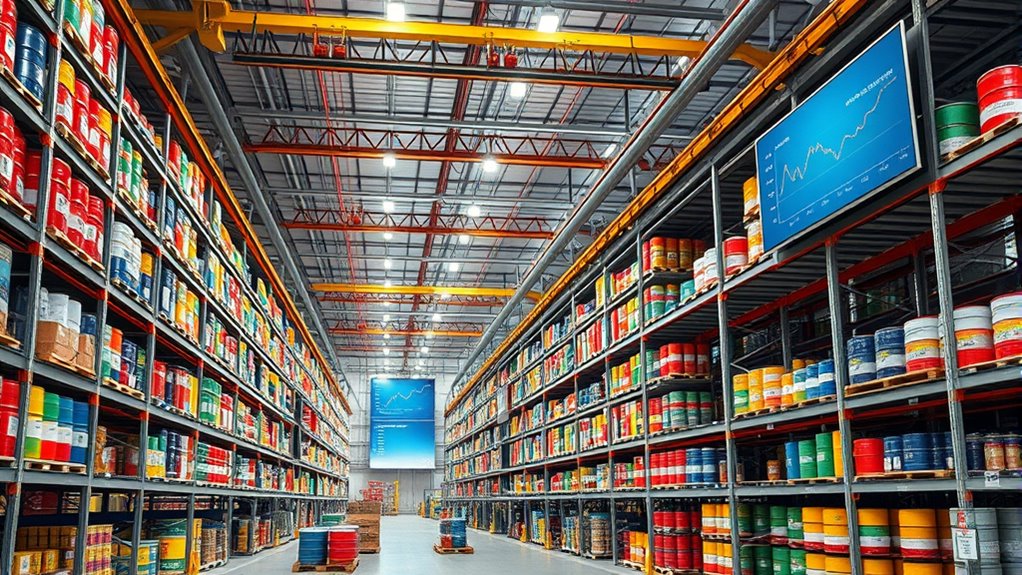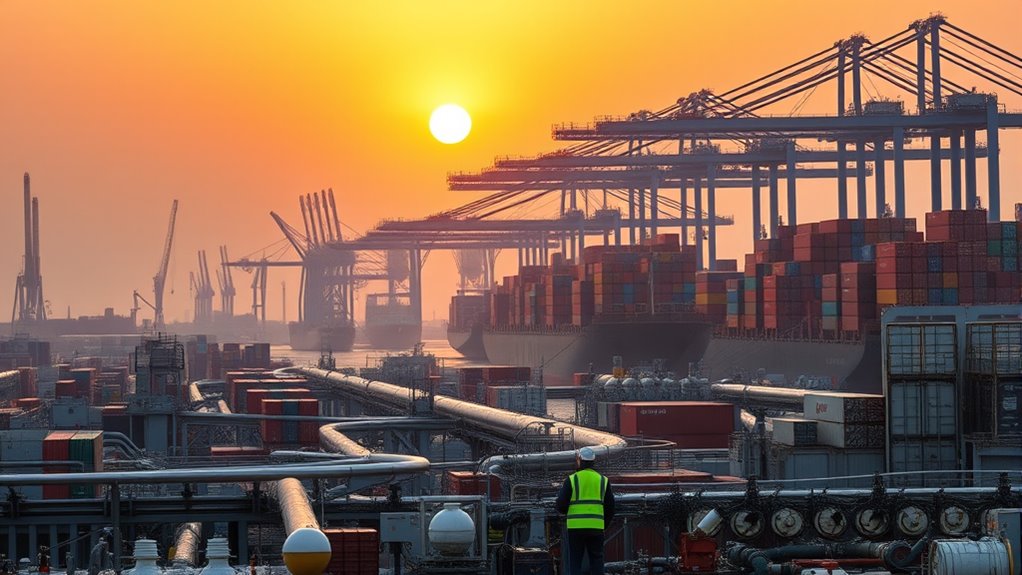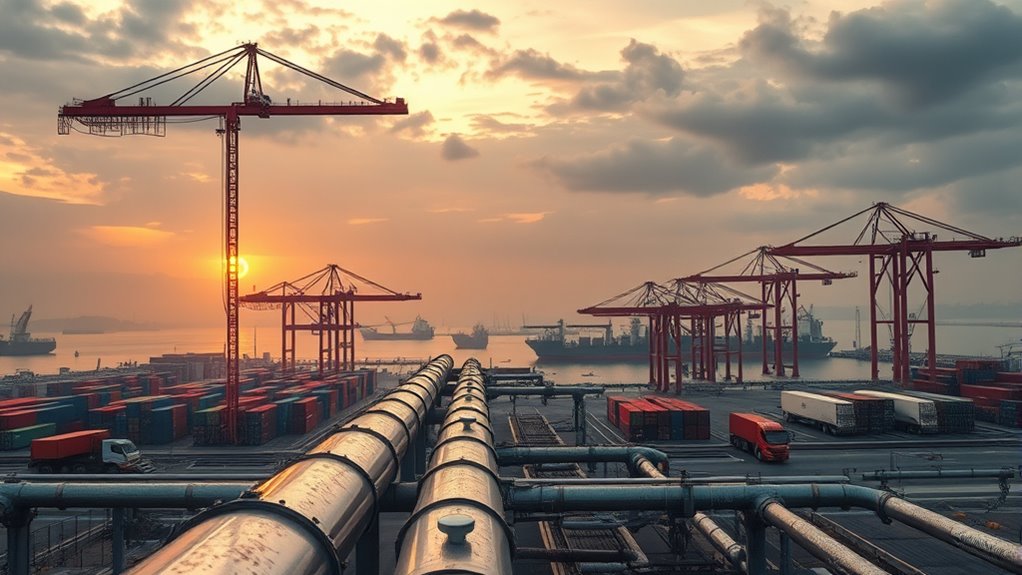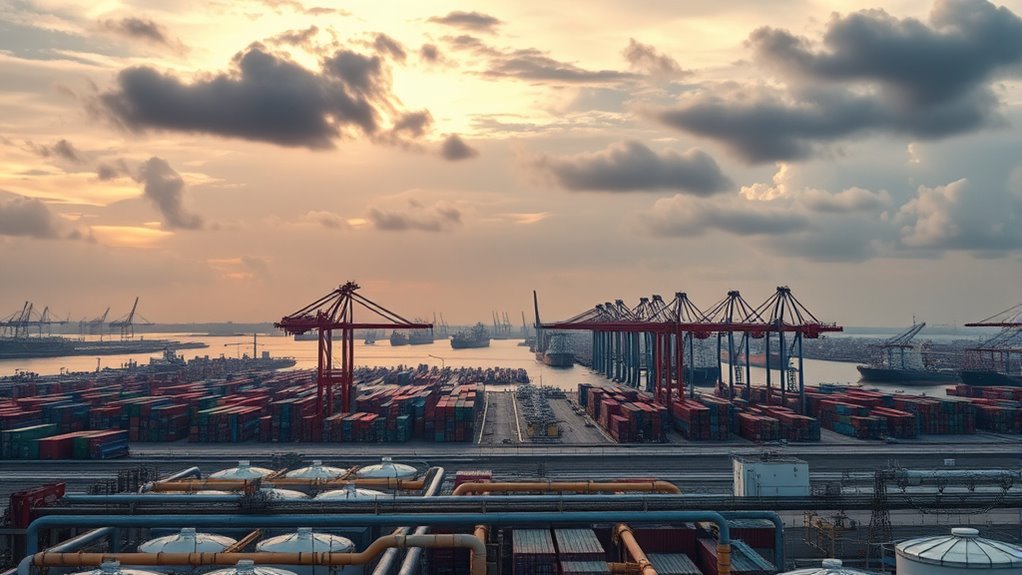Recent chemical supply chain disruptions highlight the importance of diversifying sourcing, adopting digital tools, and building flexibility into your operations. COVID-19 caused raw material shortages, transportation issues, and demand shifts, forcing companies to rethink regional manufacturing and strengthen supplier relationships. To stay resilient, you must focus on real-time visibility, risk management, and strategic planning. Discover how industry leaders are adapting and how you can implement these lessons for a more secure supply chain.
Key Takeaways
- Diversify supply sources regionally and develop secondary options to reduce dependency on global networks.
- Implement digital platforms and real-time tracking for enhanced supply chain visibility and risk mitigation.
- Adopt advanced planning tools like AI and predictive analytics to anticipate disruptions early.
- Strengthen supplier collaboration, safety stocks, and flexible logistics to improve resilience during crises.
- Develop comprehensive risk management strategies, including crisis protocols and regular simulation drills.
Understanding the Impact of COVID-19 on Chemical Supply Chains

COVID-19 profoundly disrupted chemical supply chains by causing sudden shifts in demand and market imbalances. You’d notice surges in sectors like pharmaceuticals, disinfectants, and food additives, while automotive and consumer goods saw demand drop by up to 30%. This volatility created oversupply issues, worsening pre-existing imbalances. Additionally, disruptions in transportation networks hampered the timely movement of raw materials and finished products, further complicating supply chain management. Meanwhile, crude oil prices plummeted—the biggest drop since 1991—reducing feedstock costs but shifting regional competitive advantages. The US lost its shale gas edge, impacting chemical prices and competitiveness, while Middle Eastern producers also felt the pressure. Asia experienced mixed effects, balancing lower input costs with lower output prices. These disruptions also prompted companies to rethink supply strategies, shifting production closer to markets and reducing reliance on global networks to increase resilience. Furthermore, understanding Gold IRA options has become part of diversified investment strategies as investors seek stability amidst economic uncertainties.
Key Challenges in Recent Supply Chain Disruptions

Recent supply chain disruptions in the chemical industry stem from multiple interconnected challenges that hinder timely production and delivery. Raw material shortages, such as resins and specialized acids, often halt production lines, causing delays and revenue loss. Recurring shortages of vital materials like resins and specialized acids disrupt production. Geopolitical tensions and extreme weather in resource-rich regions worsen supply volatility, forcing you to seek alternatives. Limited petrochemical feedstocks add uncertainty to costs and availability, while regulatory changes, like phasing out PFAS, demand new sourcing strategies. Transportation disruptions, port congestion, labor shortages, and strikes further delay shipments and increase costs. Workforce shortages and labor strikes, especially in Europe, result in production halts and order delays. Additionally, compliance with evolving environmental regulations raises costs and complicates sourcing, while poor supply chain visibility hampers planning and response efforts. A well-established supply chain can help mitigate some of these disruptions by providing better contingency planning and sourcing options.
Industry Responses and Strategic Adaptations

How are chemical companies actively countering supply chain disruptions? They’re diversifying supply sources by expanding suppliers across multiple regions and developing secondary options for critical chemicals. Leveraging digital platforms helps identify and vet new suppliers in emerging markets, while shifting to alternative raw materials reduces dependency on vulnerable supply chains. Digital transformation enables greater visibility and agility, allowing companies to respond swiftly to unforeseen challenges. Many adopt multi-sourcing strategies for high-demand specialty chemicals. Regionalization of manufacturing also plays a key role—local facilities near key markets cut transport delays and adapt quickly to regional demand, with investments in redundancy and compliance. Advanced planning tools like AI-driven scheduling and real-time demand syncing optimize inventory and preempt bottlenecks. Collaborating with suppliers through contingency plans, shared risk frameworks, and transparency systems ensures preparedness. Additionally, companies increase safety stocks, diversify transportation modes, and implement IoT tracking to boost logistics agility and resilience. Furthermore, leveraging supply chain resilience strategies enhances their capacity to withstand future disruptions and maintain steady operations.
Managing Risks in a Volatile Environment

In a volatile environment, chemical companies must proactively manage risks to guarantee supply chain resilience. You should establish clear crisis management strategies for incidents like spills or leaks, defining roles and responsibilities for swift, coordinated responses.
Effective communication protocols are essential to keep employees, suppliers, and customers informed during emergencies. Regular training and simulation drills ensure your team remains prepared and calm.
Building strong relationships with emergency services and regulators helps facilitate quick responses and compliance.
Embedding risk management into procurement, production, and distribution processes allows you to assess suppliers regularly and develop mitigation strategies.
Utilizing real-time analytics, supply-risk libraries, and digital platforms like IoT and blockchain enhances visibility.
Maintaining diversified suppliers and balancing inventory strategies further reduces your vulnerability to disruptions in this unpredictable environment.
Implementing self-watering plant pots strategies as an analogy can inspire innovative approaches to maintaining continuous supply and resilience.
Preparing for Future Disruptions and Building Resilience

To effectively prepare for future disruptions, you need to enhance your supply chain visibility and integrate data across all operations. Implement end-to-end digital platforms for real-time tracking of inventories, shipments, and production status.
Integrate ERP systems with advanced planning tools to enable synchronized, adaptive operations. Use predictive analytics to forecast demand and identify potential disruptions early.
Develop centralized risk libraries that compile supplier data, geopolitical risks, and environmental factors to inform decisions.
Foster cross-functional collaboration through supply chain centers of excellence, ensuring alignment with market conditions.
Diversify your suppliers geographically and include secondary or local sources to reduce reliance on vulnerable regions.
Design flexible manufacturing and distribution networks, and leverage advanced risk assessments and predictive models to build a resilient, adaptable supply chain capable of weathering future disruptions. Additionally, understanding the impact of sleep and mental health on decision-making and resilience can improve leadership and crisis management during disruptions.
Frequently Asked Questions
How Are Smaller Chemical Producers Affected by Recent Supply Chain Disruptions?
You’re considerably impacted by recent supply chain disruptions, facing raw material shortages and price swings that threaten your margins. Transportation delays and port congestions slow your shipments, while labor strikes and factory accidents disrupt operations.
Limited supplier options and logistical resources make it harder to adapt, increasing costs and reducing competitiveness. These challenges strain your capacity to maintain steady production, forcing you to navigate unpredictable costs and operational hurdles more carefully than larger competitors.
What Role Do Digital Tools Play in Improving Chemical Supply Chain Resilience?
Imagine your supply chain as a finely tuned engine. Digital tools act like sensors and gauges, providing real-time visibility and predictive insights.
You can spot disruptions early, adjust swiftly, and keep operations smooth.
With integrated systems and IoT, you monitor conditions and guarantee safety.
These technologies boost resilience, cut costs, and help you stay ahead of market changes, making your supply chain more agile and prepared for any challenge.
How Do Geopolitical Tensions Influence Global Chemical Supply Chain Stability?
You see, geopolitical tensions directly threaten your chemical supply chain stability by disrupting trade routes, causing resource shortages, and increasing costs.
Conflicts and sanctions restrict access to essential raw materials and limit exports, forcing you to seek alternative sources and adapt quickly.
These tensions also elevate transportation risks and delays, making it harder to maintain reliable supply chains.
Staying informed and diversifying suppliers can help mitigate these impacts and keep your operations resilient.
What Specific Strategies Are Companies Using to Mitigate Labor-Related Risks?
Have you ever imagined a workplace where hazards are minimized, and safety reigns? Companies tackle labor-related risks by implementing thorough training programs that keep workers aware and prepared. They adjust job schedules to reduce fatigue, rotate tasks to limit exposure, and conduct regular risk assessments.
Emergency plans and drills ensure readiness. These proactive steps create safer environments, empower workers, and reduce the chances of accidents and injuries in chemical facilities.
How Will Sustainability Regulations Impact Future Chemical Supply Chain Strategies?
Sustainability regulations will shape your future chemical supply chain strategies by pushing you to prioritize eco-friendly sourcing, reduce emissions, and guarantee transparency. You’ll need to adopt greener production methods, vet suppliers for compliance, and invest in sustainable materials.
These changes might increase costs initially but will enhance your competitive edge, improve brand reputation, and help you meet stricter legal standards. Staying proactive ensures you adapt smoothly and leverage sustainability as a market advantage.
Conclusion
As you’ve seen, recent disruptions reveal vulnerabilities in the global chemical supply chain. While industry responses have been swift, the true test lies ahead. Will your strategies withstand unforeseen shocks? The lessons learned now could determine your resilience tomorrow. Stay vigilant, adapt proactively, and prepare for surprises lurking just beyond the horizon. The next disruption might be closer than you think—and only those ready will navigate it successfully.









